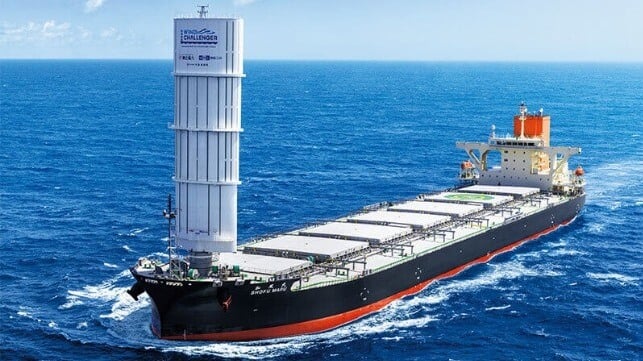MOL to Expand Wind-Assisted Propulsion After Validation on First Vessel

Mitsui O.S.K. Lines (MOL) is moving forward expanding its use of wind-assisted propulsion as part of its overall decarbonization efforts. They have test results after approximately 18 months of operation of the first vessel fitting with their rigid sail and now report they are also considering other technologies. In addition to new constructions, they are also pursuing their first retrofit of the Wind Challenger rigid sail to a bulker.
The move to expand the use of wild-assisted propulsion comes as the technology continues to draw strong interest from shipowners and operators. The International Windship Association recently said that there are a total of 37 vessels with wind-propulsion installed and in service. This represents a doubling over the past 12 months with a total of 22 installations and wind-ready ships delivered. With the emergence of the EU Fit for 55 effort and the IMO set to adopt its GHG strategies mapped out in 2023, the association expects wind propulsion installations will continue to grow.
MOL says it has accumulated extensive operational technology to pursue wind propulsion technology. The group plans to launch 25 vessels equipped with the Wind Challenger by 2030, increasing to 80 by 2035. MOL is scheduled to deploy its second vessel, a 64,000 dwt bulker, with the Wind Challenger in June and today reported a total of six additional newbuilding bulk carriers, 42,000 dwt and 58,000 dwt, and one multipurpose vessel.
The Wind Challenger is a rigid sail made of fiberglass with a width of about 50 feet and a maximum height of about 175 feet. Its sections are nested so that it can retract to a fraction of its operating height to reduce air draft. The mounting point is forward, on the bow, and well clear of the cargo hatches. MOL working with Oshima Shipbuilding has been perfecting the design and preparing it for commercialization since 2018.

MOL will retrofit the sail for the first time in 2025 to an in-service bulker (MOL)
MOL reports three bulkers have been ordered from Oshima Shipbuilding Co. with preparations underway for three additional contracts. The first three bulkers, due in the second half of 2026 and the first half of 2027, will each be fitted with the Wind Challenger rigid sail and it is considering also adding up to three wind rotors per vessel manufactured by Anemoi Marine Technologies on some of these vessels. MOL expects the combined use of both technologies to reduce fuel and GHG emissions by an average of about 15-28 percent per year. The other three bulkers, so far, are planned to have just the Wind Challenger. MOL previously also agreed to install two Norse rotors on a 200,000 dwt bulker operated for Vale with that installation expected to be completed this year.
MOL Drybulk has also decided to install two Ventfoils, a foldable and autonomous unit for wind-assisted ship propulsion, manufactured by EconoWind. The technology will be installed on one of its new multipurpose vessels (17,500 dwt) slated for delivery in 2025 and operation under a time charter.
Next year, MOL also plans the first retrofit of a Wind Challenger to an in-service bulker. The first of its third-generation bulkers, the Kurotakisan Maru III (89,999 dwt), which entered service in December 2021 and carries coal for J-Power will add the rigid sail. The retrofitting of the Wind Challenger aboard this second vessel is expected to reduce greenhouse gas (GHG) emissions by about five percent on a Japan-Australia voyage and about eight percent on a Japan-North America West Coast voyage, compared to a conventional vessel of the same type.
Recently, MOL also released data from its first vessel using the Wind Challenger, the Shofu Maru (100,000 dwt), which entered service in October 2022. The vessel has completed seven round-trip voyages to Japan mainly from Australia, Indonesia, and North America operating as a dedicated coal carrier for Tohoku Electric.
Daily fuel consumption over the 18 months since the vessel entered service was reduced by up to 17 percent. On average the fuel saving has been between five and eight percent per voyage. MOL notes that the data was calculated using a method verified by Lloyd’s Register of Shipping and that the fuel saving during operation depends largely on wind conditions. The Wind Challenger does not produce thrust when the vessel encounters a headwind.
